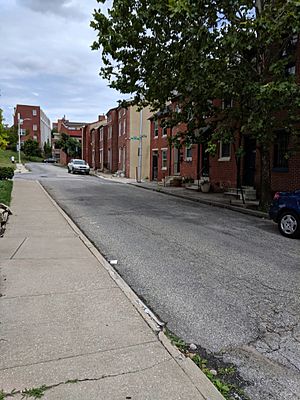Washington Hill, Baltimore facts for kids
Quick facts for kids
Washington Hill
|
|
|---|---|
|
Neighborhood of Baltimore
|
|
 |
|
| Country | United States |
| State | Maryland |
| City | Baltimore |
| Time zone | UTC-5 (Eastern) |
| • Summer (DST) | EDT |
| Area code | 410, 443, and 667 |
Washington Hill is a neighborhood in Baltimore, Maryland, United States. It is located near several other well-known areas. To its north is Fells Point, and to its south is Johns Hopkins Hospital. Old Town and Jonestown are to the west, while Butchers Hill is to the east.
The neighborhood's borders are Fayette Street, Washington Street, Lombard Street, and Central Avenue. A main road called Broadway runs through Washington Hill. It starts in Fells Point and goes north to North Avenue.
Washington Hill gets its name from the old Washington Medical College. This college later became the Church Home and Hospital. The famous writer and poet Edgar Allan Poe was taken there in 1849 after being found very unwell in downtown Baltimore. In the middle of Broadway, there is a statue of Ferdinand Claiborne Latrobe. He was the mayor of Baltimore seven times.
The City Springs School, which is a charter school, is located in Washington Hill. This school was one of only two in Baltimore City to be removed from the state's list of struggling schools. Fairmount Heights Vocational High School, which is now closed, was also in this area. Nearby, you can find City Springs Park, which has places for fun activities.
Contents
Who Lives in Washington Hill?
This section shares information about the people living in Washington Hill.
Population and Backgrounds
In 2010, about 7,937 people lived in the neighborhood. The community is made up of many different groups of people. About 29.1% were White, 57.2% were African American, and 1.3% were Native American. Also, 2.2% were Asian, and 3.1% were from other backgrounds. About 2.2% of the people identified with two or more backgrounds. People of Hispanic or Latino heritage made up 11.3% of the population.
Washington Hill is home to many families whose ancestors came from different countries. These include Ireland, Czech Republic, Russia, and Poland. The neighborhood also has people from the Appalachian mountains and Lumbee Native American communities.
Work and Income
About 60.0% of the people living in Washington Hill had jobs. Around 7.7% were looking for work but did not have a job. The remaining 31.9% were not part of the working population. The average household income in the neighborhood was $36,138. About 16.3% of families and 23.8% of the population had very low incomes.
Making Washington Hill Better
This section talks about how the community worked to improve the neighborhood.
Community Improvement Efforts
In 1974, a group called Citizens for Washington Hill was formed. This group, supported by the government, aimed to create a plan to make the community better. Betty Hyatt became the leader of this organization.
Under her leadership, the group helped create homes and studios for artists. These were located on the 1500 and 1600 blocks of East Baltimore Street. They also helped fix up many homes throughout the neighborhood.
Washington Hill Mutual Homes
A very successful project was the creation of Washington Hill Mutual Homes. This is a special type of housing where residents own their homes together as a cooperative. There are over 200 homes in this cooperative, mainly along Broadway and on East Fairmount and East Baltimore Streets.
This project has been a great example of how a community can lead its own housing development. Important visitors like Prince Charles of England and President Jimmy Carter have even come to see it.
Images for kids


